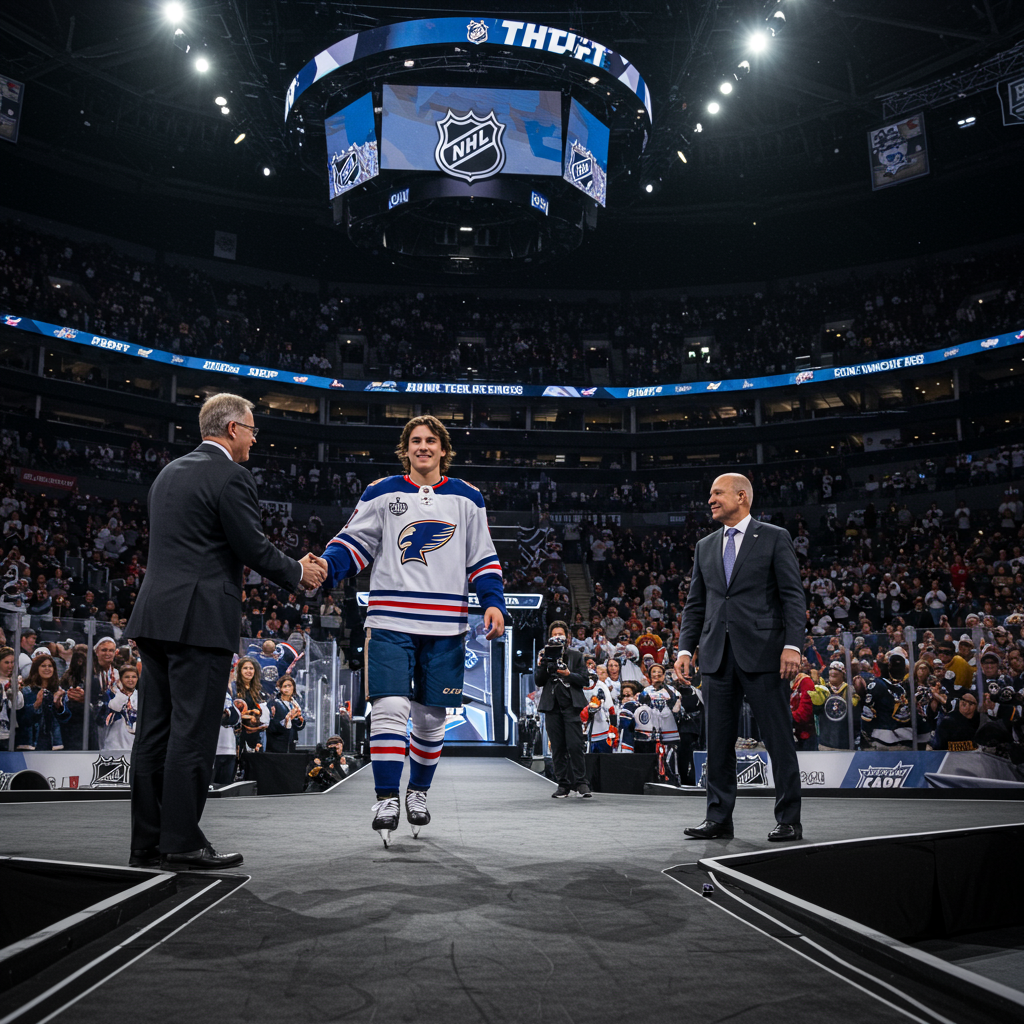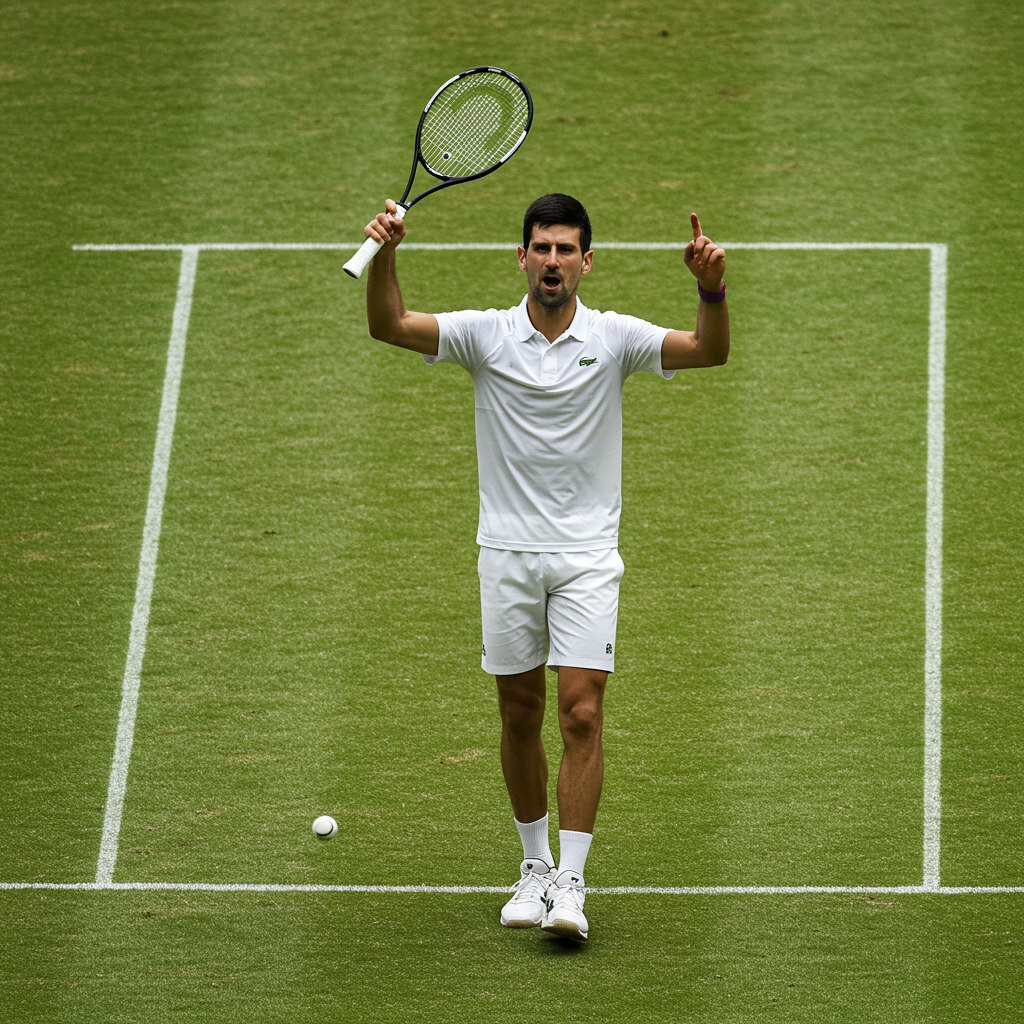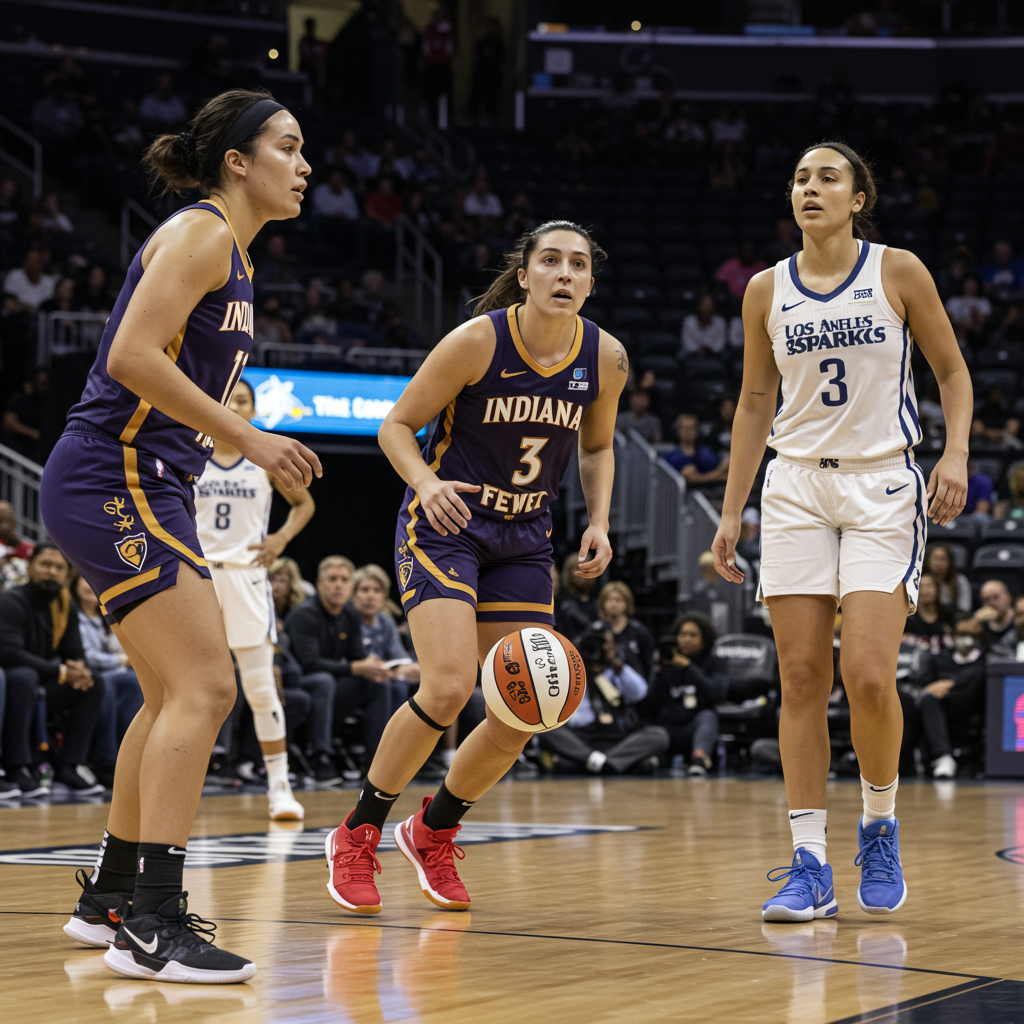The highly anticipated first round of the 2025 Upper Deck NHL draft is officially complete! Held at L.A. Live’s Peacock Theater in Los Angeles, the event saw 32 promising young players hear their names called, setting the stage for the future of the National Hockey League. This year’s draft marked a notable shift in format, with teams making selections remotely from their home arenas, an experiment that generated considerable discussion and mixed reviews throughout the evening.
Schaefer Goes First Overall as Islanders Lead the Way
As widely anticipated, the New York Islanders kicked off the draft by selecting defenseman Matthew Schaefer first overall. The 17-year-old Erie Otters standout, despite a season-ending collarbone injury, is celebrated for his exceptional compete level, leadership qualities, and impressive hockey IQ. Scouting reports highlight his strong defensive skills, including excellent coverage, shot-blocking, and physicality, paired with offensive capabilities like strong zone exits and the ability to join the rush, drawing comparisons to top two-way defensemen.
The Islanders were busy even before the draft floor opened, notably acquiring two additional first-round picks from Montreal in a trade involving defenseman Noah Dobson. They used these assets to further bolster their prospect pool, selecting right-winger Victor Eklund at No. 16 and defenseman Kashawn Aitcheson at No. 17. This gave the Islanders three first-round selections, a strategy also pursued by Pittsburgh, Nashville, and Chicago, who likewise made three picks each in the opening round.
Top Prospects Shine in Early Selections
Following Schaefer, the San Jose Sharks used the second pick to nab Michael Misa, a highly skilled and creative center from the OHL. Misa, an OHL scoring champion before an injury, is known for his tremendous hockey sense, offensive instincts, and two-way play, projecting as a top-line center in the mold of Aleksander Barkov.
The Chicago Blackhawks addressed their needs at third overall by drafting Anton Frondell, a Swedish forward lauded for his size, strength against men, disruption on the forecheck, and heavy shot. Utah, selecting fourth, opted for Caleb Desnoyers, described by some as potentially the draft’s most complete player, noted for his polish, defensive responsibility, leadership, and combination of size, skill, and aggression. Nashville added physicality and intensity with Brady Martin at No. 5, an attacking center known for relentless forechecking and winning puck battles.
Teams Prioritize Size, Skill, and Strategic Trading
The first round saw teams implement diverse strategies, often leveraging trades to target specific players or accumulate assets. The Philadelphia Flyers were a prime example, making significant moves to add size and power. After taking 6-foot-3 power winger Porter Martone at sixth overall, the Flyers traded picks No. 22 and 31 to Pittsburgh to move up to No. 12. This move allowed them to select 6-foot-4 center Jack Nesbitt, a highly-rated, rapidly improving player. Flyers GM Danny Briere noted the trade-up was specifically for Nesbitt, highlighting his blend of skill and physicality. Martone and Nesbitt, who previously attended the same school, now join forces in the Flyers’ system.
Other notable early picks included James Hagens (No. 7, Boston), a dynamic offensive catalyst; Jake O’Brien (No. 8, Seattle), a smooth, two-way center; Radim Mrtka (No. 9, Buffalo), a massive, mobile defenseman; Roger McQueen (No. 10, Anaheim), a talented forward who dropped due to injury concerns; and Ben Kindel (No. 11, Pittsburgh), an undersized, instinctive playmaker.
The Columbus Blue Jackets were also active, making significant trades before and during the draft. They acquired forwards Charlie Coyle and Miles Wood from Colorado, though it cost them prospect Gavin Brindley and their 2025 third-rounder. With their two first-round picks (No. 14 and 20, both acquired via trade), they selected defenseman Jackson Smith and goaltender Pyotr Andreyanov. Andreyanov was the first goalie taken, a somewhat surprising but statistically impressive pick.
Several trades punctuated the first round itself, including Pittsburgh moving up to 12 via Philadelphia, Nashville acquiring pick 21 from Ottawa, and Chicago moving up to 29 via Carolina. These maneuvers underscore the value teams placed on specific spots to land their desired prospects.
An Experimental Draft Format Yields Mixed Reviews
The 2025 NHL Draft featured a unique decentralized format, with teams operating from their home arenas while prospects, media, and league officials gathered in Los Angeles. This experimental approach aimed to potentially offer teams more privacy for trade discussions and involve local fanbases.
However, the format received mixed feedback. While some elements were deemed acceptable, the “virtual Draft House” segments showcasing prospects interacting remotely were widely criticized as awkward and uninteresting. Commissioner Gary Bettman’s public comments have suggested openness to returning to the traditional format, indicating the league might not commit long-term to the decentralized model despite some positive moments, like the “Big Red Button” used for trade announcements. The lack of anticipated early trades, particularly involving the Islanders’ multiple top picks, also surprised some observers, leading to questions about whether the format delivered on its potential benefits.
Here is the complete order of selection from the first round of the 2025 Upper Deck NHL Draft:
Complete 2025 NHL Draft First Round Order
- NY Islanders – Matthew Schaefer (Defenseman, Erie Otters – OHL)
- San Jose – Michael Misa (Center, Saginaw Spirit – OHL)
- Chicago – Anton Frondell (Center, Djurgårdens IF J20 – Sweden Jr.)
- Utah – Caleb Desnoyers (Center, Moncton Wildcats – QMJHL)
- Nashville – Brady Martin (Center, Soo Greyhounds – OHL)
- Philadelphia – Porter Martone (Right Wing, Brampton Steelheads – OHL)
- Boston – James Hagens (Center, USNTDP)
- Seattle – Jake O’Brien (Center, Erie Otters – OHL)
- Buffalo – Radim Mrtka (Defenseman, Spokane Chiefs – WHL)
- Anaheim – Roger McQueen (Center, Brandon Wheat Kings – WHL)
- Pittsburgh – Ben Kindel (Left Wing, Calgary Hitmen – WHL)
- Philadelphia (from PIT via VAN via NYR) – Jack Nesbitt (Center, Windsor Spitfires – OHL)
- Detroit – Carter Bear (Left Wing, Everett Silvertips – WHL)
- Columbus (from MIN) – Jackson Smith (Defenseman, Tri-City Americans – WHL)
- Vancouver – Braeden Cootes (Center, Medicine Hat Tigers – WHL)
- Montreal (from CGY) – Victor Eklund (Right Wing, Frölunda HC J20 – Sweden Jr.)
- Montreal – Kashawn Aitcheson (Defenseman, Barrie Colts – OHL)
- Calgary (from NJD) – Cole Reschny (Center, Victoria Royals – WHL)
- St. Louis – Justin Carbonneau (Right Wing, Chicoutimi Saguenéens – QMJHL)
- Columbus (from MIN) – Pyotr Andreyanov (Goaltender, CSKA Jr. – Russia Jr.)
- Nashville (from OTT) – Cameron Reid (Defenseman, Tri-City Storm – USHL)
- Pittsburgh (from PHI/from COL) – Bill Zonnon (Right Wing, Acadie–Bathurst Titan – QMJHL)
- Ottawa (from NSH/from TBL) – Logan Hensler (Defenseman, University of Denver – NCAA)
- Pittsburgh (from LAK) – Will Horcoff (Right Wing, Tri-City Americans – WHL)
- Chicago (from TOR) – Vaclav Nestrasil (Right Wing, Fargo Force – USHL)
- Nashville (from VGK via SJS) – Ryker Lee (Center, Wenatchee Wild – WHL)
- Washington – Lynden Lakovic (Left Wing, Moose Jaw Warriors – WHL)
- Winnipeg – Sascha Boumedienne (Defenseman, Youngstown Phantoms – USHL)
- Chicago (from CAR) – Mason West (Center, USNTDP)
- San Jose (from DAL) – Joshua Ravensbergen (Goaltender, Prince George Cougars – WHL)
- Los Angeles (from PIT/from PHI/from EDM) – Henry Brzustewicz (Defenseman, Michigan State University – NCAA)
- Calgary (from FLA) – Cullen Potter (Center, Arizona State University – NCAA)
Looking Ahead: Day 2 and Beyond
With the first round completed, teams will reset for Day 2 of the 2025 NHL Draft, scheduled to begin at 12 p.m. ET on Saturday, June 28. Rounds 2 through 7 will see hundreds more prospects selected, offering teams opportunities to deepen their organizational talent pools. Following the draft, the focus of the hockey world will quickly shift to NHL Free Agency, set to open shortly thereafter, promising another flurry of transactions and roster changes across the league.
Frequently Asked Questions
What were the major outcomes of the first round of the 2025 NHL Draft?
The first round saw defenseman Matthew Schaefer selected first overall by the New York Islanders. Other top picks included Michael Misa (San Jose, #2), Anton Frondell (Chicago, #3), Caleb Desnoyers (Utah, #4), and Brady Martin (Nashville, #5). Several teams, including the Islanders, Penguins, Predators, and Blackhawks, made three selections in the opening round, signaling a focus on adding significant prospect depth.
How was the 2025 NHL Draft format different this year, and how did it go?
This year’s draft utilized a decentralized format where teams made their selections remotely from their home arenas, diverging from the traditional single-location model. While the main event was staged in Los Angeles, general managers were not on stage. The format received mixed reviews; elements like the “virtual Draft House” were criticized, while the “Big Red Button” for trades was seen positively. League comments suggest a potential return to the traditional format in the future.
What are some notable storylines or team strategies from the first round?
Key storylines included teams prioritizing size and physicality, as seen with the Philadelphia Flyers trading up to select Jack Nesbitt after taking Porter Martone. The Columbus Blue Jackets were active with pre-draft trades before picking defenseman Jackson Smith and goaltender Pyotr Andreyanov, the first goalie taken. The experimental decentralized format itself was a major talking point, as was the surprising lack of high-profile trades involving top picks early in the round.
The first round of the 2025 NHL Draft provided teams with foundational pieces for their future rosters, highlighted by the selection of Matthew Schaefer at No. 1. As teams shift their focus to Day 2 and the subsequent free agency period, the decisions made during this opening round will be analyzed for years to come as the drafted prospects develop.
Word Count Check: 1078



